Condition Monitoring of an All-Terrain Vehicle Gear Train Assembly Using Deep Learning Algorithms with Vibration Signals
Abstract
1. Introduction
2. Experimental Setup
3. Experimental Procedure
4. Feature Extraction and Feature Selection
5. Feature Classification Using the Tree Family Algorithms
6. Results and Discussion
- ➢
- While driving, any simulated faults in the ATV can be identified immediately.
- ➢
- This study will help implement online gear health monitoring in ATVs, ensuring the safety of drivers.
7. Conclusions
Author Contributions
Funding
Institutional Review Board Statement
Informed Consent Statement
Data Availability Statement
Acknowledgments
Conflicts of Interest
References
- Zhao, H.; Wu, Q.; Huang, K.; Qiu, M.; Liu, P. Status and problem research on gear study. J. Mech. Eng. 2013, 49, 11–20. [Google Scholar] [CrossRef]
- Rincon, A.F.d.; Viadero, F.; Iglesias, M.; de-Juan, A.; Garcia, P.; Sancibrian, R. Effect of cracks and pitting defects on gear meshing. Proc. Inst. Mech. Eng. Part C J. Mech. Eng. Science 2012, 226, 2805–2815. [Google Scholar] [CrossRef]
- Wang, T.; Han, Q.; Chu, F.; Feng, Z. Vibration based condition monitoring and fault diagnosis of wind turbine planetary gearbox: A review. Mech. Syst. Signal Process. 2019, 126, 662–685. [Google Scholar] [CrossRef]
- Feng, K.; Ji, J.; Ni, Q.; Beer, M. A review of vibration-based gear wear monitoring and prediction techniques. Mech. Syst. Signal Process. 2023, 182, 109605. [Google Scholar] [CrossRef]
- Lei, Y.; Lin, J.; Zuo, M.J.; He, Z. Condition monitoring and fault diagnosis of planetary gearboxes: A review. Measurement 2014, 48, 292–305. [Google Scholar] [CrossRef]
- Praveenkumar, T.; Saimurugan, M.; Ramachandran, K. Intelligent Fault Diagnosis of Synchromesh Gearbox Using Fusion of Vibration and Acoustic Emission Signals for Performance Enhancement. Int. J. Progn. Health Manag. 2019, 10, 1–11. [Google Scholar] [CrossRef]
- Talukdar, S.; Eibek, K.U.; Akhter, S.; Ziaul, S.; Islam, A.R.M.T.; Mallick, J. Modeling fragmentation probability of land-use and land-cover using the bagging, random forest and random subspace in the Teesta River Basin, Bangladesh. Ecol. Indic. 2021, 126, 107612. [Google Scholar] [CrossRef]
- Yuvaraju, E.C.; Rudresh, L.R.; Saimurugan, M. Vibration signals based fault severity estimation of a shaft using machine learning techniques. Mater. Today Proc. 2020, 24, 241–250. [Google Scholar] [CrossRef]
- Sharma, V.; Parey, A. A review of gear fault diagnosis using various condition indicators. Procedia Eng. 2016, 144, 253–263. [Google Scholar] [CrossRef]
- Natarajan, S. Vibration signal analysis using histogram features and support vector machine for gear box fault diagnosis. Int. J. Syst. Control. Commun. 2017, 8, 57–71. [Google Scholar] [CrossRef]
- Mohanraj, T.; Yerchuru, J.; Krishnan, H.; Aravind, R.N.; Yameni, R. Development of tool condition monitoring system in end milling process using wavelet features and Hoelder’s exponent with machine learning algorithms. Measurement 2021, 173, 108671. [Google Scholar] [CrossRef]
- Altaf, M.; Akram, T.; Khan, M.A.; Iqbal, M.; Ch, M.M.I.; Hsu, C.-H. A New Statistical Features Based Approach for Bearing Fault Diagnosis Using Vibration Signals. Sensors 2022, 22, 2012. [Google Scholar] [CrossRef]
- Meena, R.; Nair, B.B.; Sakthivel, N. Machine Learning Approach to Condition Monitoring of an Automotive Radiator Cooling Fan System. In Advances in Electrical and Computer Technologies, Proceedings of the ICAECT 2019: First International Conference in Advances in Electrical and Computer Technologies, Coimbatore, India, 26–27 April 2019; Sengodan, T., Murugappan, M., Misra, S., Eds.; Springer: Berlin/Heidelberg, Germany, 2020; pp. 1007–1020. [Google Scholar]
- Sharma, A.; Sugumaran, V.; Devasenapati, S.B. Misfire detection in an IC engine using vibration signal and decision tree algorithms. Measurement 2014, 50, 370–380. [Google Scholar] [CrossRef]
- Kumar, N.; Sakthivel, G.; Jegadeeshwaran, R.; Sivakumar, R.; Kumar, S. Vibration based IC engine fault diagnosis using tree family classifiers-a machine learning approach. In Proceedings of the 2019 IEEE International Symposium on Smart Electronic Systems (iSES) (Formerly iNiS), Rourkela, India, 16–18 December 2019; pp. 225–228. [Google Scholar]
- Saravanan, N.; Ramachandran, K. Fault diagnosis of spur bevel gear box using discrete wavelet features and Decision Tree classification. Expert Syst. Appl. 2009, 36, 9564–9573. [Google Scholar] [CrossRef]
- Charbuty, B.; Abdulazeez, A. Classification based on decision tree algorithm for machine learning. J. Appl. Sci. Technol. Trends 2021, 2, 20–28. [Google Scholar] [CrossRef]
- Sugumaran, V.; Jain, D.; Amarnath, M.; Kumar, H. Fault diagnosis of helical gear box using decision tree through vibration signals. Int. J. Perform. Eng. 2013, 9, 221. [Google Scholar]
- Li, X.; Li, J.; Qu, Y.; He, D. Semi-supervised gear fault diagnosis using raw vibration signal based on deep learning. Chin. J. Aeronaut. 2020, 33, 418–426. [Google Scholar] [CrossRef]
- Medina, R.; Cerrada, M.; Cabrera, D.; Sánchez, R.-V.; Li, C.; De Oliveira, J.V. Deep learning-based gear pitting severity assessment using acoustic emission, vibration and currents signals. In Proceedings of the 2019 Prognostics and System Health Management Conference (PHM-Paris), Paris, France, 2–5 May 2019; pp. 210–216. [Google Scholar]
- Toh, G.; Park, J. Review of vibration-based structural health monitoring using deep learning. Appl. Sci. 2020, 10, 1680. [Google Scholar] [CrossRef]
- Tama, B.A.; Vania, M.; Lee, S.; Lim, S. Recent advances in the application of deep learning for fault diagnosis of rotating machinery using vibration signals. Artif. Intell. Rev. 2022, 55, 1–43. [Google Scholar] [CrossRef]
- Fu, Q.; Wang, H. A novel deep learning system with data augmentation for machine fault diagnosis from vibration signals. Appl. Sci. 2020, 10, 5765. [Google Scholar] [CrossRef]
- Zhu, X.; Liu, B.; Li, Z.; Lin, J.; Gao, X. Research on Deep Learning Method and Optimization of Vibration Characteristics of Rotating Equipment. Sensors 2022, 22, 3693. [Google Scholar] [CrossRef]
- Li, X.; Li, J.; Qu, Y.; He, D. Gear pitting fault diagnosis using integrated CNN and GRU network with both vibration and acoustic emission signals. Appl. Sci. 2019, 9, 768. [Google Scholar] [CrossRef]
- Karabacak, Y.E.; Gürsel Özmen, N.; Gümüşel, L. Worm gear condition monitoring and fault detection from thermal images via deep learning method. Eksploat. Niezawodn. 2020, 22, 544–556. [Google Scholar] [CrossRef]
- Boiadjiev, I.; Witzig, J.; Tobie, T.; Stahl, K. Tooth flank fracture–basic principles and calculation model for a sub-surface-initiated fatigue failure mode of case-hardened gears. In Proceedings of the International Gear Conference, Lyon, France, 26–28 August 2014; pp. 1–7. [Google Scholar]
- Lewicki, D.G.; Ballarini, R. Gear crack propagation investigations. Tribotest 1998, 5, 157–172. [Google Scholar] [CrossRef]
- Beckman, M. Gear failure analysis. Tribol. Lubr. Technol. 2019, 75, 24–32. [Google Scholar]
- Jegadeeshwaran, R.; Sugumaran, V. Comparative study of decision tree classifier and best first tree classifier for fault diagnosis of automobile hydraulic brake system using statistical features. Measurement 2013, 46, 3247–3260. [Google Scholar] [CrossRef]
- Jegadeeshwaran, R.; Sugumaran, V. Brake fault diagnosis using Clonal Selection Classification Algorithm (CSCA)—A statistical learning approach. Eng. Sci. Technol. Int. J. 2015, 18, 14–23. [Google Scholar] [CrossRef]
- Bhargava, N.; Sharma, G.; Bhargava, R.; Mathuria, M. Decision tree analysis on j48 algorithm for data mining. Proc. Int. J. Adv. Res. Comput. Sci. Softw. Eng. 2013, 3, 1114–1119. [Google Scholar]
- Kalmegh, S.R. Comparative analysis of weka data mining algorithm randomforest, randomtree and ladtree for classification of indigenous news data. Int. J. Emerg. Technol. Adv. Eng. 2015, 5, 507–517. [Google Scholar]
- Javed Mehedi Shamrat, F.; Ranjan, R.; Hasib, K.M.; Yadav, A.; Siddique, A.H. Performance Evaluation Among ID3, C4. 5, and CART Decision Tree Algorithm. In Pervasive Computing and Social Networking, Proceedings of the International Conference on Pervasive Computing and Social Networking(ICPCSN 2021), Salem, India, 19–20 March 2021; Springer: Berlin/Heidelberg, Germany, 2022; pp. 127–142. [Google Scholar]
- Belgiu, M.; Drăguţ, L. Random forest in remote sensing: A review of applications and future directions. ISPRS J. Photogramm. Remote Sens. 2016, 114, 24–31. [Google Scholar] [CrossRef]
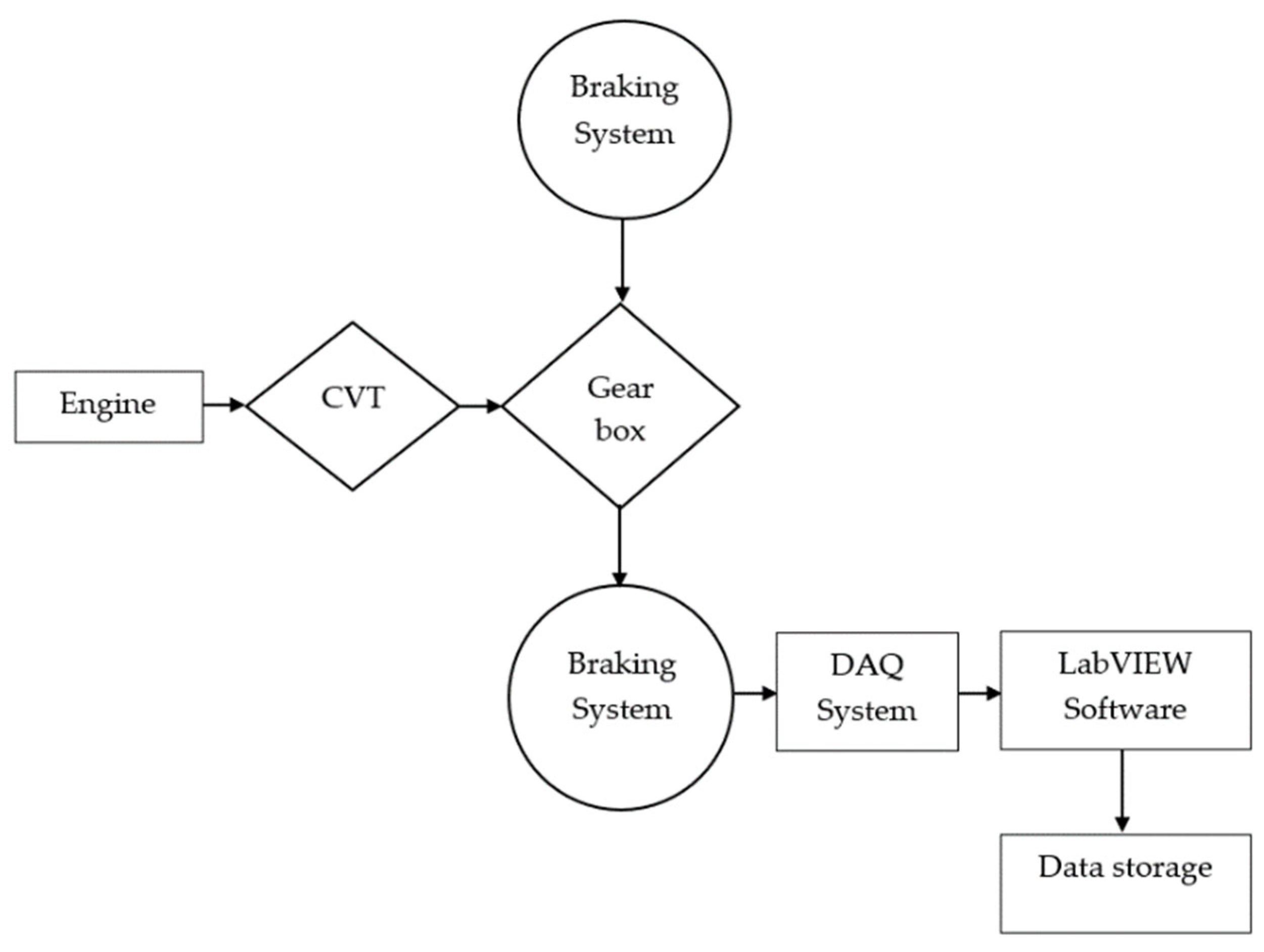
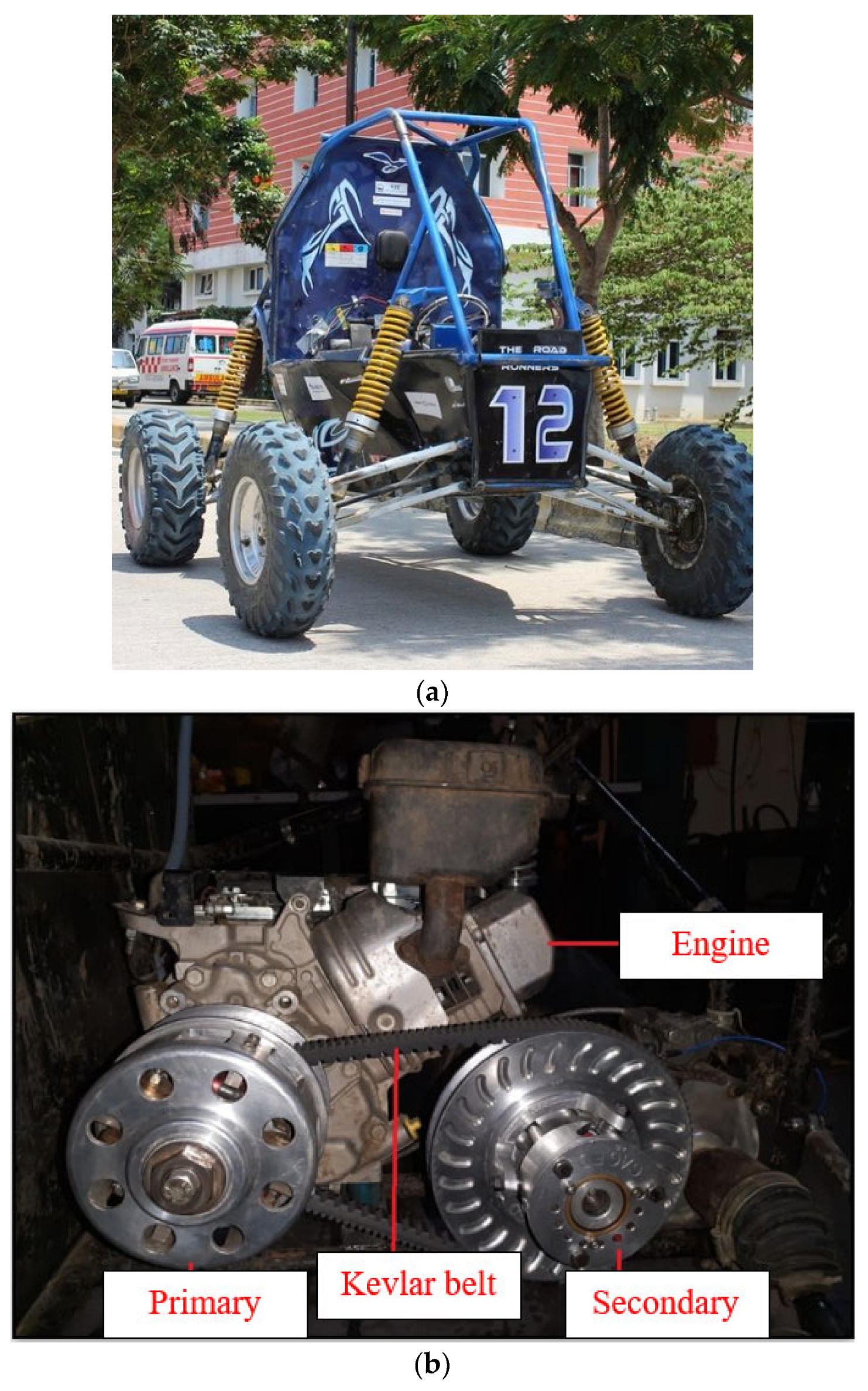
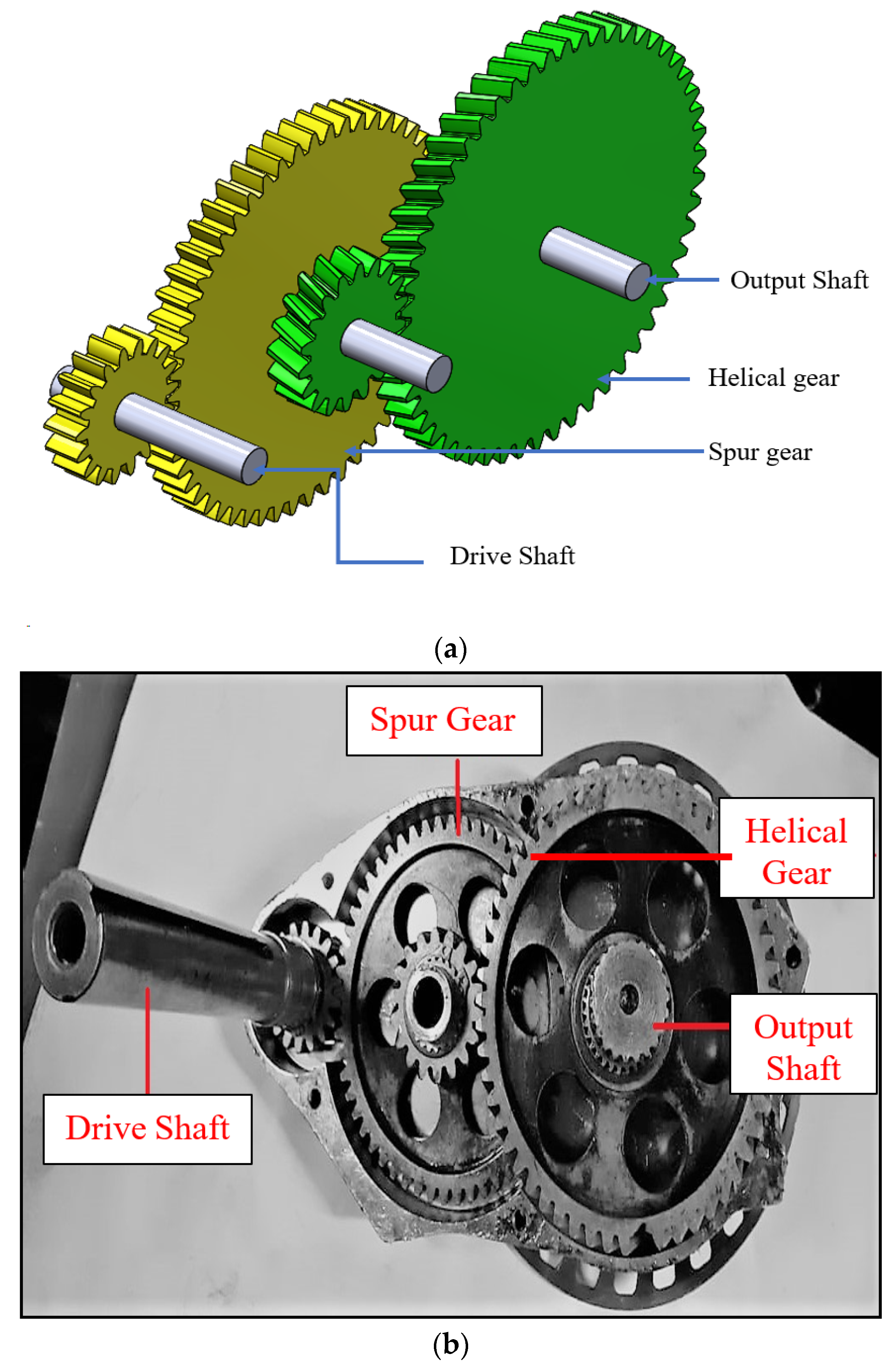
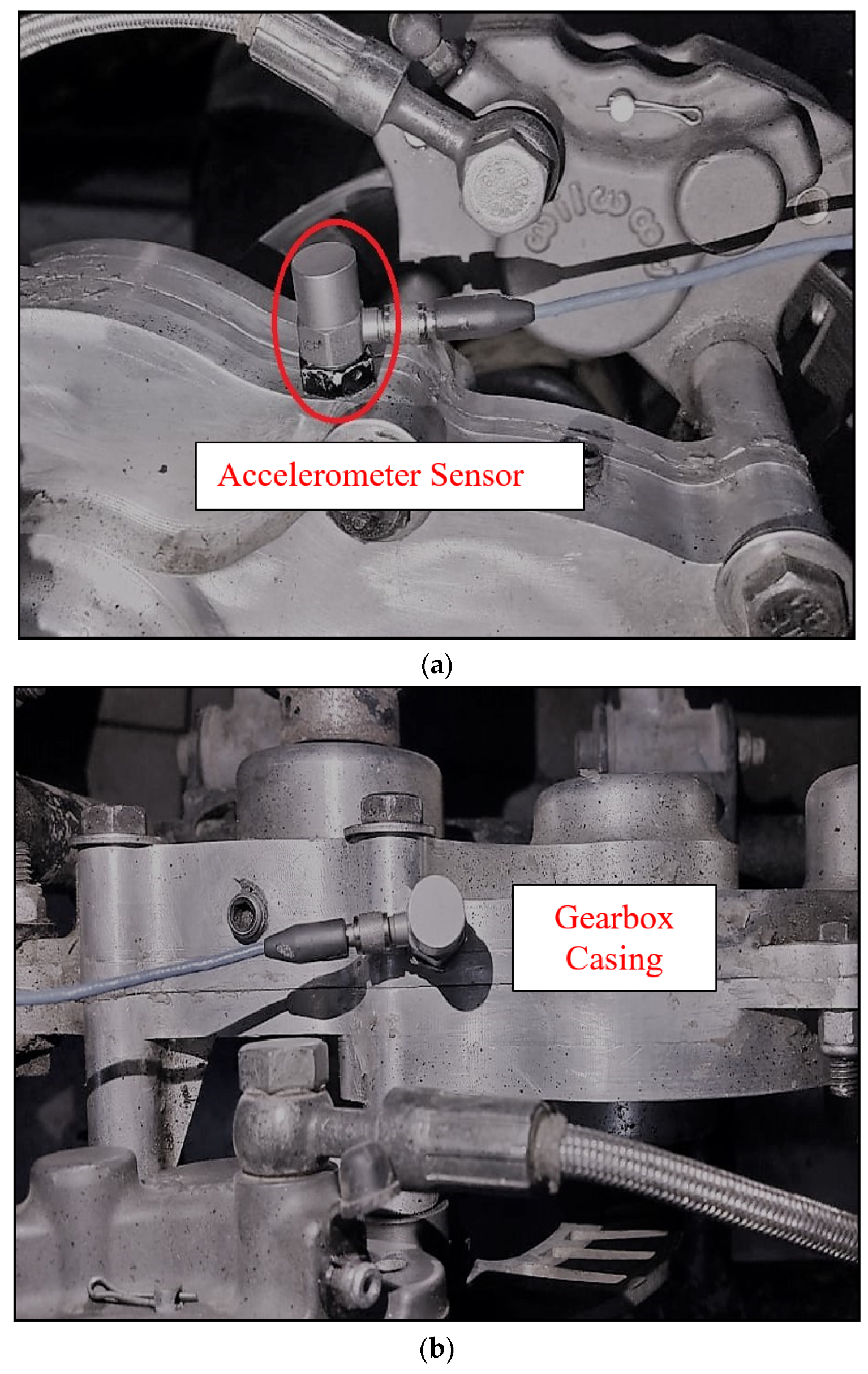


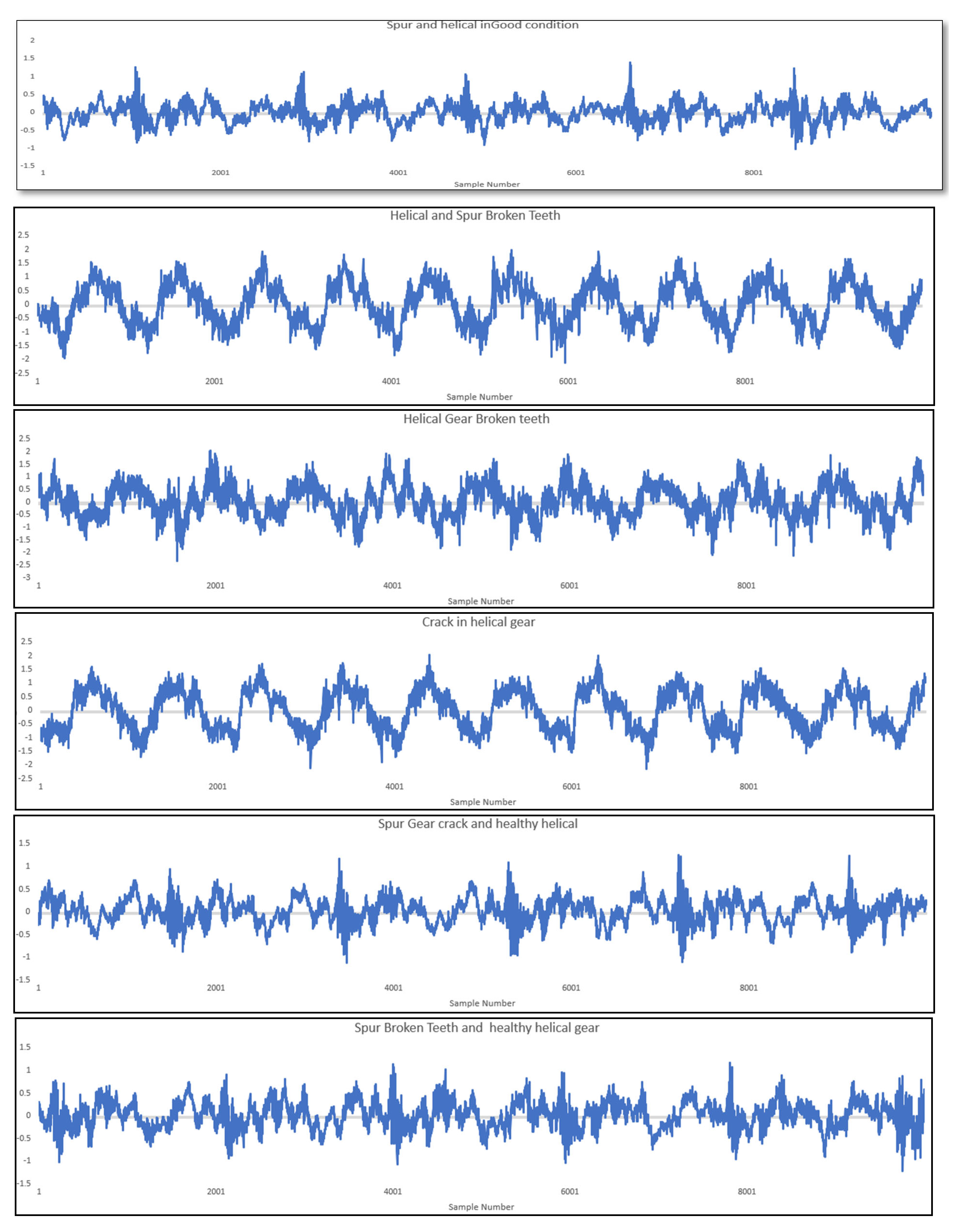
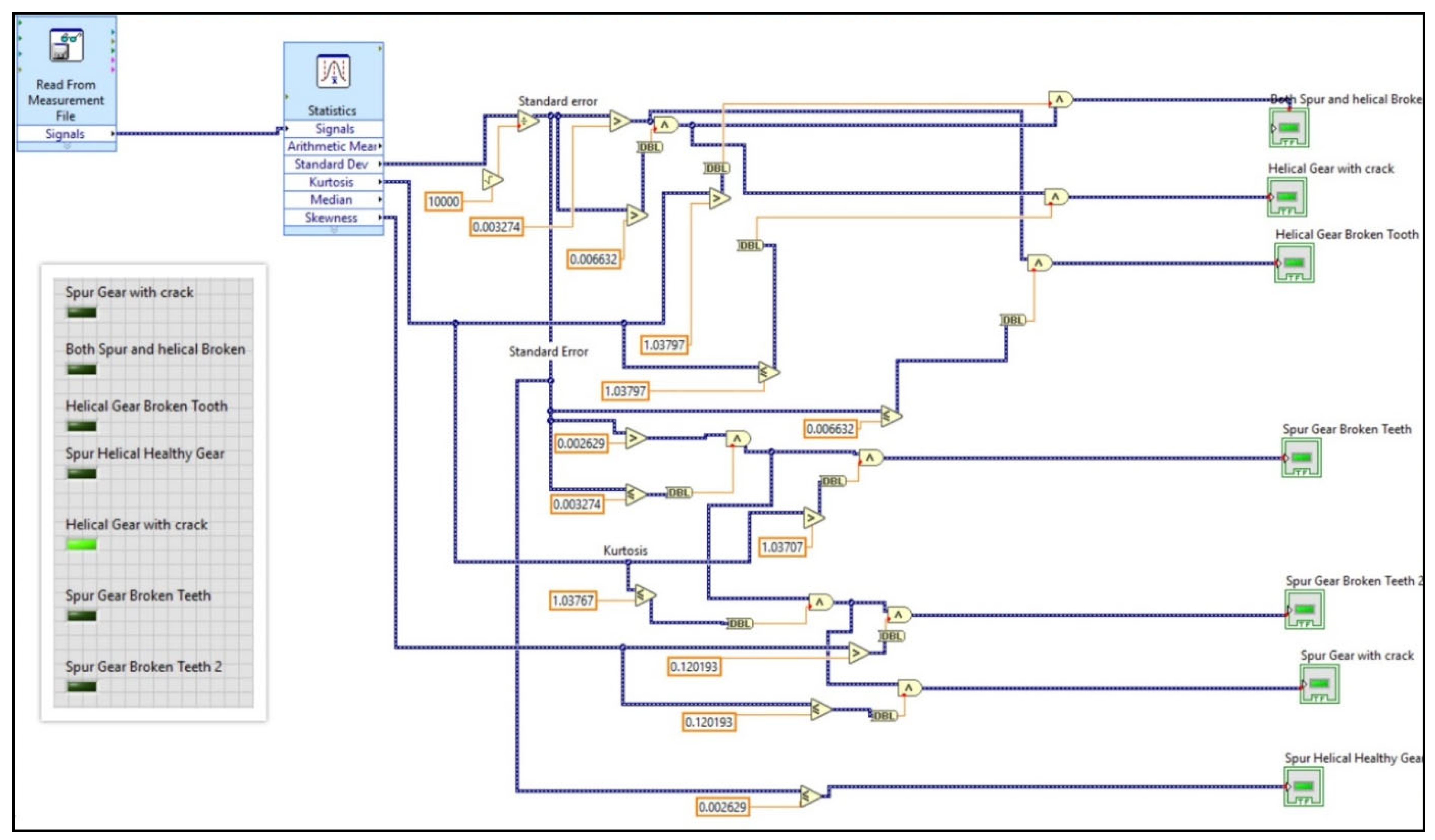
| Parameters | Spur Pinion | Spur Gear | Helical Pinion | Helical Gear |
|---|---|---|---|---|
| No. of teeth | 18 | 54 | 18 | 54 |
| Module (mm) | 2 | 2 | 2 | 2 |
| Normal Pressure angle (Degree) | 20 | 20 | 20 | 20 |
| Helix angle (Degree) | - | - | 20 | 20 |
| Tooth Thickness (mm) | 14 | 14 | 23 | 20 |
| Material | EN353 | EN353 | EN353 | EN353 |
| Gears | Spur | Helical |
|---|---|---|
| SHHC | Without defects | Without defects |
| SGWC | Crack | Without defects |
| SGBT | Broken tooth | Without defects |
| HGWC | Without defects | Crack |
| HGBT | Without defects | Broken tooth |
| HSBT | Broken tooth | Broken tooth |
| Engine Speed (RPM) | Loading Condition (N) |
|---|---|
| 1500 | 0 |
| 1800 | 280 |
| 2000 | 280 |
| No. of Features | Random Forest | Decision Tree | Random Tree |
|---|---|---|---|
| 1 | 40.17 | 42.17 | 40.17 |
| 2 | 95.50 | 95.67 | 95.33 |
| 3 | 97.00 | 95.50 | 94.00 |
| 4 | 96.83 | 95.00 | 96.83 |
| 5 | 96.33 | 95.00 | 96.67 |
| 6 | 97.50 | 97.50 | 97.33 |
| 7 | 99.00 | 98.33 | 97.00 |
| 8 | 99.00 | 98.33 | 98.17 |
| 9 | 98.83 | 98.17 | 98.17 |
| 10 | 98.67 | 98.33 | 98.67 |
| 11 | 98.67 | 98.33 | 98.33 |
| 12 | 98.67 | 98.33 | 98.17 |
| Speed | Random Forest | Decision Tree | Random Tree |
|---|---|---|---|
| 1500 | 90.34 | 93.93 | 89.72 |
| 1800 | 99.00 | 98.33 | 98.67 |
| 2000 | 98.83 | 98.16 | 96.83 |
| Confusion Matrix | ||||||
|---|---|---|---|---|---|---|
| A | B | C | D | E | F | Classified as |
| 98 | 2 | 0 | 0 | 0 | 0 | A = SHHC |
| 2 | 97 | 1 | 0 | 0 | 0 | B = SGWC |
| 0 | 1 | 99 | 0 | 0 | 0 | C = SGBT |
| 0 | 0 | 0 | 100 | 0 | 0 | D = HGWC |
| 0 | 0 | 0 | 0 | 100 | 0 | E = HGBT |
| 0 | 0 | 0 | 0 | 0 | 100 | F = HSBT |
Publisher’s Note: MDPI stays neutral with regard to jurisdictional claims in published maps and institutional affiliations. |
© 2022 by the authors. Licensee MDPI, Basel, Switzerland. This article is an open access article distributed under the terms and conditions of the Creative Commons Attribution (CC BY) license (https://creativecommons.org/licenses/by/4.0/).
Share and Cite
Gnanasekaran, S.; Jakkamputi, L.; Thangamuthu, M.; Marikkannan, S.K.; Rakkiyannan, J.; Thangavelu, K.; Kotha, G. Condition Monitoring of an All-Terrain Vehicle Gear Train Assembly Using Deep Learning Algorithms with Vibration Signals. Appl. Sci. 2022, 12, 10917. https://doi.org/10.3390/app122110917
Gnanasekaran S, Jakkamputi L, Thangamuthu M, Marikkannan SK, Rakkiyannan J, Thangavelu K, Kotha G. Condition Monitoring of an All-Terrain Vehicle Gear Train Assembly Using Deep Learning Algorithms with Vibration Signals. Applied Sciences. 2022; 12(21):10917. https://doi.org/10.3390/app122110917
Chicago/Turabian StyleGnanasekaran, Sakthivel, Lakshmipathi Jakkamputi, Mohanraj Thangamuthu, Senthil Kumar Marikkannan, Jegadeeshwaran Rakkiyannan, Kannan Thangavelu, and Gangadhar Kotha. 2022. "Condition Monitoring of an All-Terrain Vehicle Gear Train Assembly Using Deep Learning Algorithms with Vibration Signals" Applied Sciences 12, no. 21: 10917. https://doi.org/10.3390/app122110917
APA StyleGnanasekaran, S., Jakkamputi, L., Thangamuthu, M., Marikkannan, S. K., Rakkiyannan, J., Thangavelu, K., & Kotha, G. (2022). Condition Monitoring of an All-Terrain Vehicle Gear Train Assembly Using Deep Learning Algorithms with Vibration Signals. Applied Sciences, 12(21), 10917. https://doi.org/10.3390/app122110917












